The March To The East
With the fall of the Third Reich, the Allies began their unstoppable march into the Soviet Union. The Soviets tried to stop the combined might of Western Europe, but the destruction of the Red Air Force prevented any major counterattacks. Strangely, President Roosevelt began wondering why the Poles adopted fascism even as American tanks came rolling into Krakow.
The increasing popularity of democratic parties gave some hope that the destruction of fascism was imminent, but General Eisenhower pressed onward. One downside viewed through the lens of history is that the command staff only had a limited understanding of the residual effects of radiation in the Soviet Union, which would cause a spike in cancer rates after the war.
The worst of the radiation would pass once Allied forces got to Kiev, but the divisions that would be charged with taking the city were advised by allied scientists to stay out of an area stretching from ground zero to the eastern outskirts of the city. The tacticians agreed, noting that the devastation left little cover and nothing to capture that was of any strategic value.
The Allies continued to push the offensive line forward.
The Fall Of Minsk
The Byelorussian region of the Soviet Union was secured by the beginning of October, 1945. Although SHAEF was concerned about the approach of winter, several cracks began to open up in the Soviet lines as their manufacturing base collapsed. The Allied armies were well-provisioned, but President Roosevelt and General Eisenhower became concerned about what might happen once winter set in. Therefore, they rushed to end the war in the European theater before Christmas.
General Eisenhower pushed several divisions through the gaps in the Soviet line. While the offensive met with some resistance, it soon became impossible to stop as the organization of the Soviet Army dwindled down to nothing.
The Destruction Of Vladivostok
Greek divisions led the offensive into Vladivostok, but were ordered to stay on the outskirts of the city so that Allied strategic bombers could unleash hell on the Soviet seaport. Once they were able to take the city, there was effectively nothing left. Fires raged uncontrollably throughout the city, driving what was left of the opposition to surrender.
The Soviet Union was rapidly turning into a barren wasteland, but such was the price of war. Luckily, the horror in Europe would soon be over.
Mind The Pocket
The collapse of the Soviet Army left its’ underlying command structure in disarray, forcing them to grind to a halt in at least two locales in Eastern Europe. The first was found on the borders between Hungary, Romania, and Yugoslavia. A detachment of Swedish and American divisions made short work of the enemy there, preventing any chance of a breakout.
Not that it would help matters. The ongoing destruction of the Soviet Union would prevent the Red divisions from being resupplied at all.
Dangerous Times, Dangerous Games.
Vladivostok finally collapsed in the middle of October, prompting the Allied effort in Asia to turn north and south. Several divisions would be order to advance into Siberia, but the bulk of the Allied forces under General MacArthur would be ordered to take the Korean peninsula. While the Allies met with little resistance, the ongoing fight appeared to be a dress rehearsal for the much-feared invasion of Japan.
But that would have to wait for the end of the war in Europe.
Securing The Black Sea
The Allied offensive into the Soviet Union continued to meet with success through the end of October. However, it came at a staggering cost. Allied casualties continued to mount, forcing President Roosevelt to consider dropping more atomic bombs. Although Allied planners were worried that they would have supply problems, the opening of ports on the western side of the Black Sea culminated in the atomic bombing of Sevastopol.
The city would not be taken for a little while, but the U.S. Army Air Force reported that the manufacturing base in the city was decimated.
As winter set in, the Soviet lines had disintegrated in Ukraine. While the U.S. Army would have a few supply problems and trouble adapting to the cold, they met with no resistance in the south. The little resistance that was left concentrated on defending Moscow from the approaching Allies. The commissars were ordered to fight to the end, but they were often denied a chance to die in battle because the U.S. Army simply went around them.
The same could be said of the rest of the United Nations, but some divisions were left behind to contain the Reds and force them to surrender.
Nobody Expects The Spanish Invasion.
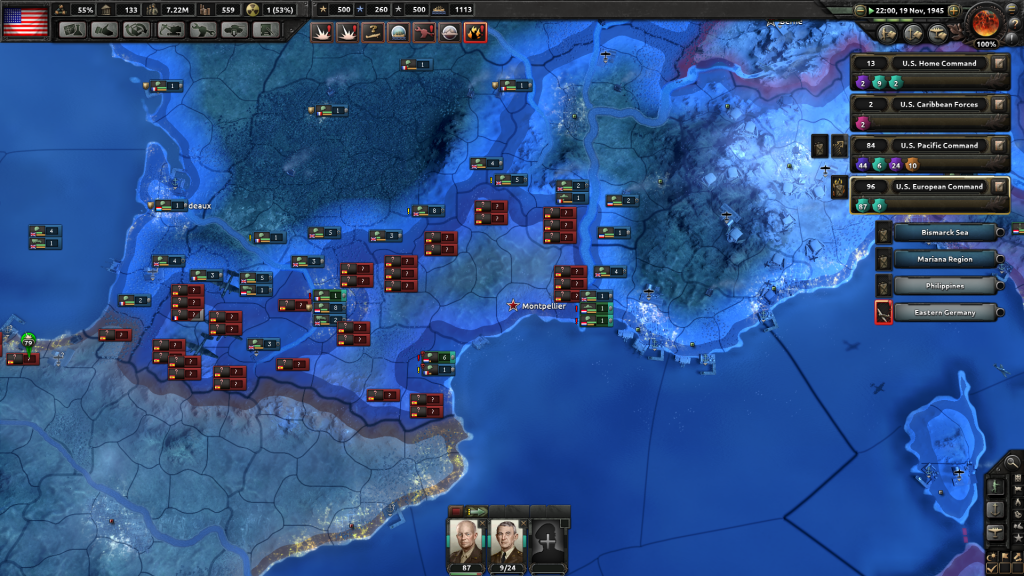
Franco foolishly ordered his forces to attack France in the Winter of 1945. It would be his last mistake.
Rather than stay out of the war, Spanish Dictator Francisco Franco ordered his army to cross the border into France in November of 1945, reigniting the war in Western Europe. His forces were able to penetrate into about ten percent of the French heartland before they were stopped cold. French and British forces held the line against the Spaniards, turning the tide against them before December.
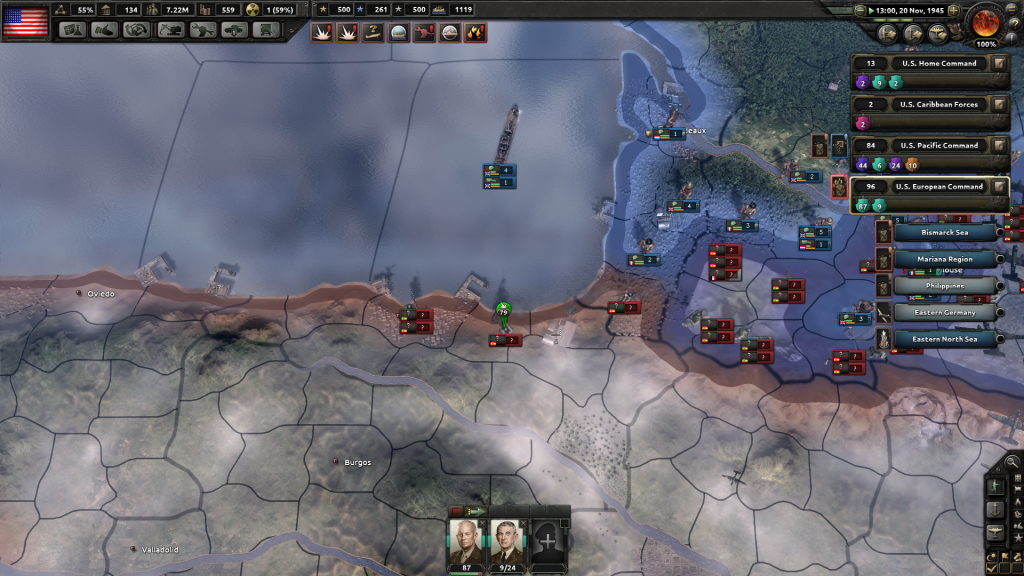
While American forces were engaged in the Soviet Union, the rest of the Allies had little trouble containing the fascists.
Street To Street
The Soviets were able to adjust their defensive lines in the south, but it did little to slow the Allied advance into Ukraine. Constant engagements prevented the remnants of the Red Army from maneuvering, allowing the U.S. Army to seize Krivoi Rih, Dnipropetrovsk, and Zaporozhe by December.
But even then, U.S. air supremacy over Europe and Japan dictated that more atomic weapons should be dropped.
The Soviets, Spanish, And Japanese Refuse To Surrender.
President Roosevelt and the Allied High Command sent out open calls for unconditional surrender to the Japanese Empire, Soviet Union, and Nationalist Spain. He implored the enemy to cease their wanton aggression, citing the humanitarian crisis that was emerging with the coming of winter. While the atomic bombings took their toll, continued strategic bombings racked up even more civilian and military casualties than the Manhattan Project did.
Sadly, the calls for surrender were ignored or refused. President Roosevelt had no choice but to respond with several more bombs. In a radio address to the nation, he stated that “he would do all that was necessary to save our boys and bring them home.”
The Raging Fire
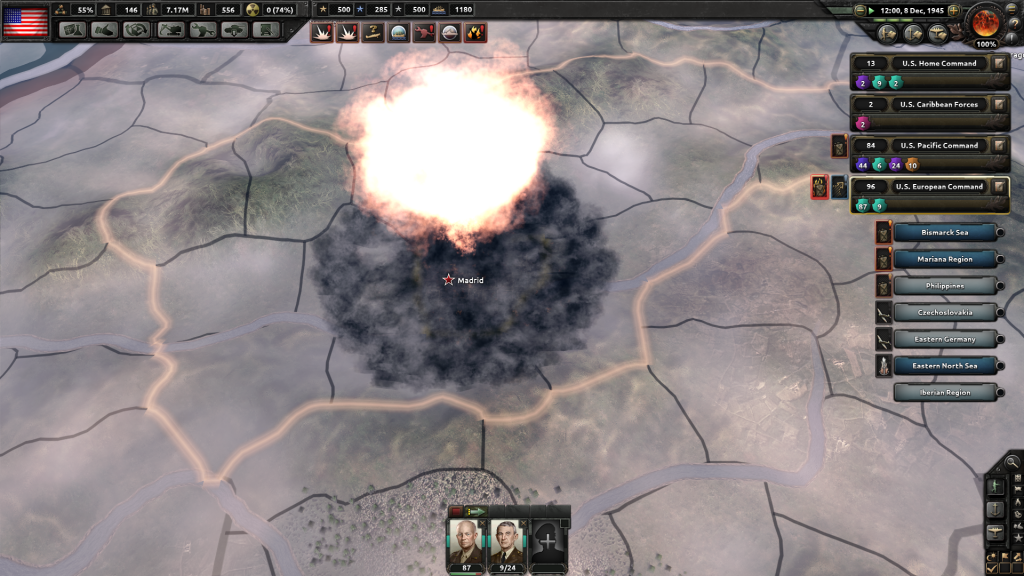
Francisco Franco was killed when Madrid was destroyed in atomic fire. No one really knows why he started the war, but future generations would curse him for it.
As the Allies neared victory in Europe, they began to turn their attention towards striking at the Japanese Home Islands. Like their fellow totalitarians in the Soviet Union and Spain, the Japanese refused the call to surrender. Therefore, President Roosevelt ordered the destruction of Hiroshima.
Christmas of 1945 would be a somber one. While the Allies pressed on, the general public soon discovered what would become the largest humanitarian crisis in recorded history. The stubborn resistance of the Soviets had left hundreds of thousands to die in gulags and POW camps. While some of them were Allied prisoners, the vast majority were Soviet citizens and dissidents that dared to call for the end of the war.
While the U.S. was growing tired of the war, Allied propagandists released censored versions of the story to the general public.
It was at about this time that news of Nazi extermination camps began to surface as well. Although the camps had been liberated when the Reich collapsed, it took some time for the Allies to uncover the true extent of the horrors of the Nazi regime. While the Allied advance saved some of the victims, it was estimated that millions of innocents were murdered and untold more were forced to work as slave labor.
The Japanese Resistance
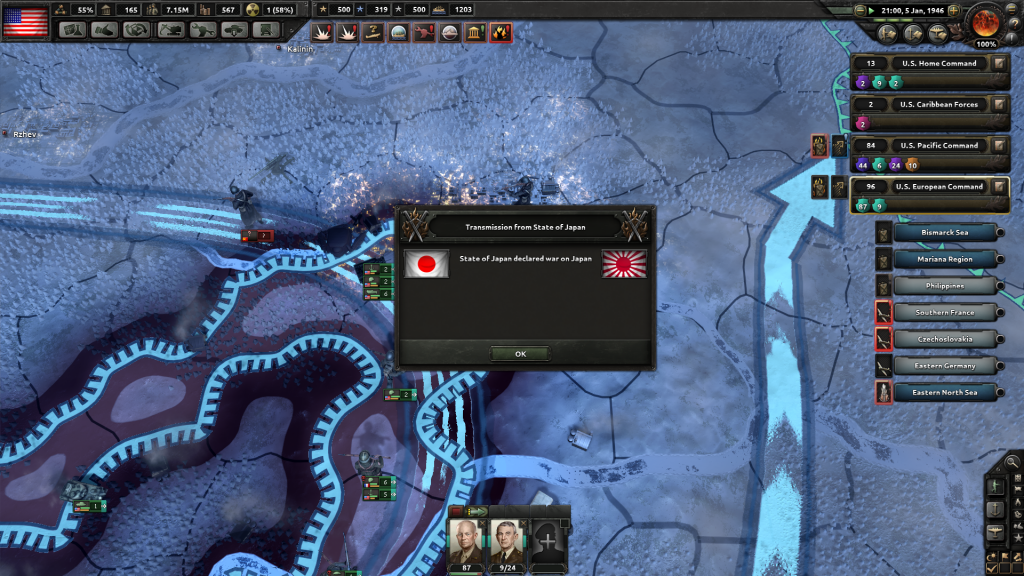
Hoping to save what was left of their country, the Japanese rose up with the assistance of the Office of Strategic Services.
Moscow fell to the Allies in January of 1946, bringing new hope that the war would be over soon. Meanwhile, the State of Japan formed a new democratic government in the Japanese Home Islands under U.S. guidance. Unfortunately, they lacked much of the infrastructure to sustain a sufficient fighting force or gain ground.
The Invasion of Japan would have to come soon or not at all.
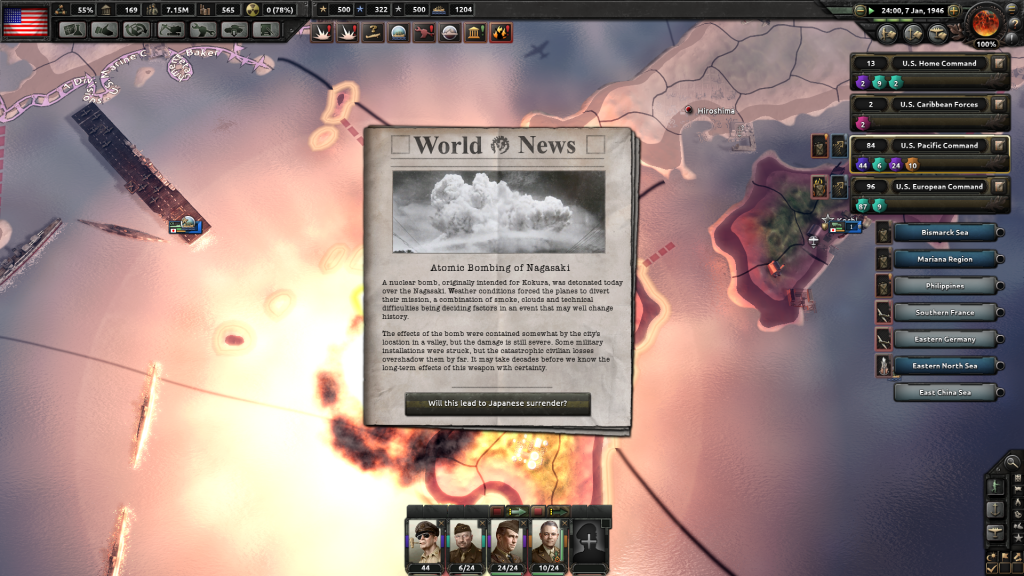
Although some portions of the Japanese Home Islands were now in Allied hands, Nagasaki still served as a military base for the Imperial Japanese Army.
The fall of Nagasaki compelled the Emperor of Japan to launch an offensive against those who rose up against him. While Allied forces massed in Korea, Taiwan, Iwo Jima, and the Phillippines, the U.S. offered all the industrial support that it could to the Free Japanese Army. Unfortunately, it would not be enough to stop the war.
That would require a more direct approach.
The Stalingrad Corridor
The Stalingrad Corridor was another example of brilliantly executed lightning tactics, even though Ike and his team were forced to deal with more casualties in the winter. If the limited Soviet resistance didn’t kill his men, the cold would do the trick on some of them. While some of the attrition was mitigated in the drive to Stalingrad, the bombed out husk that was the Soviet Union left little cover for the garrisons to the north.
While the men complained about the freezing temperatures, their morale remained quite high. The fighting had wound down, and many were treated to chocolate and some movies once they hunkered down.
Barcelona
While the fight against the Spanish continued, many assumed that it would be only a matter of time before the Allies took apart that nation piece-by-piece. Mass panic set in with the destruction of Barcelona, but little else happened on that front. The Allies had to wait to pull divisions from Russia before victory over Spain could be achieved.
Their wait would soon be over.
Victory Over Communism!
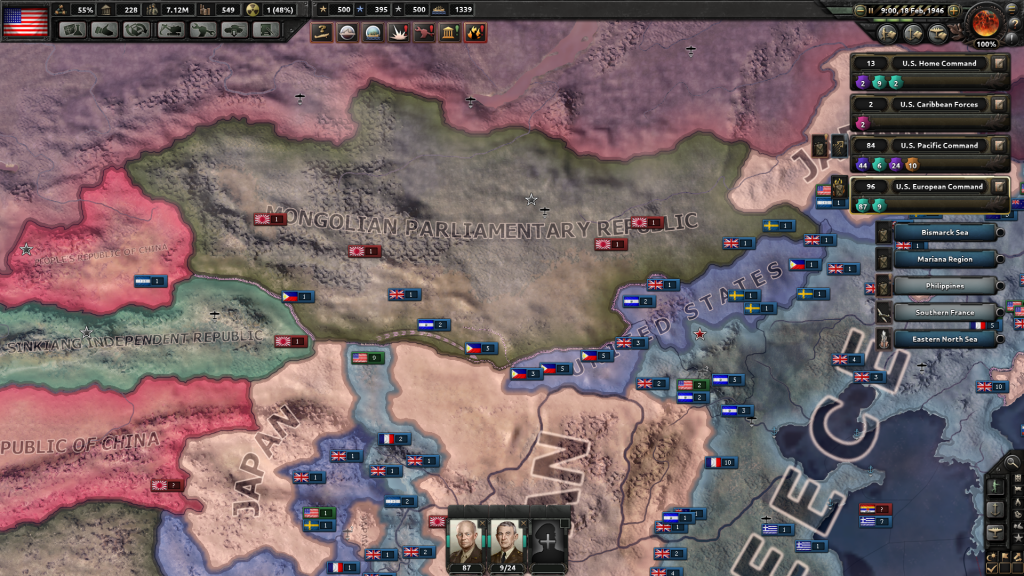
The Soviet Union fell apart twenty-four years after its’ founding. In its’ place, democracies rose up that would help those tortured regions transition into a new era.
With peace restored in Eastern Europe, a number of geopolitical changes occurred with the breakup of the Soviet Union. The fall of communism as a political ideology brought about independence for Mongolia and a number of other territories. In the west, the Russian Federation was formed as a transitional government away from communist practices. However, they could only exert control over a chunk of Russian land surrounding Moscow.
Much of the rest of the occupation would be formally entrusted to Poland, as it was the first victim of Soviet aggression in Europe. While that nation no longer had a fascist government, the measure was a token one at best. Poland did not have the resources to fully patrol the Siberian wilderness, but they could extract reparations to rebuild their industrial base.
The Russians were headed for an uncertain future, but Stalin and the Politburo would be put on trial to account for their crimes against the Russian people and the West. That had to count for something.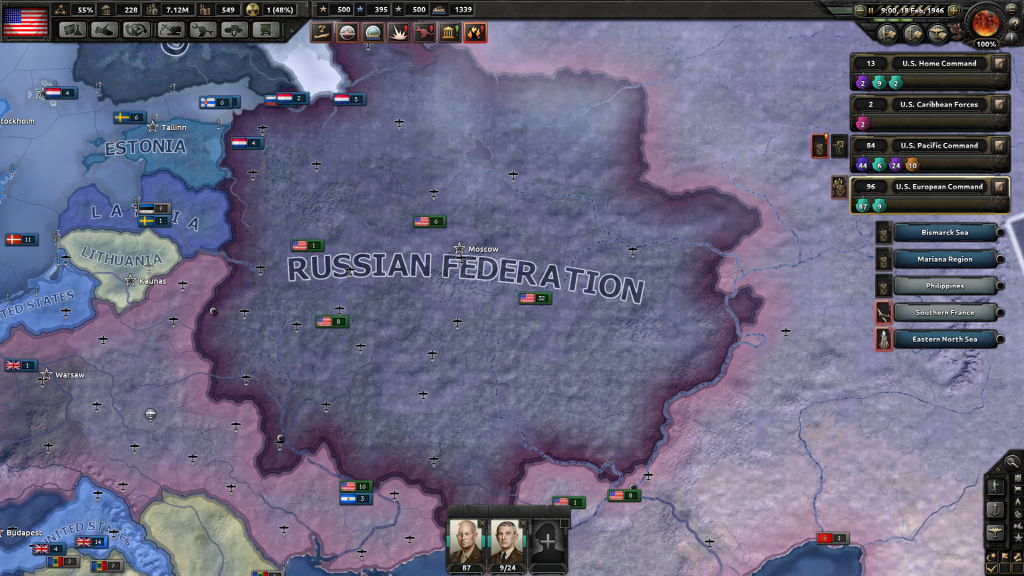
Check Out Part 7 – The Grand Finale!
If you like what you see here, consider buying Hearts of Iron IV via Amazon. Links are in the sidebar or below this post! Enjoy!
Hearts of Iron IV Copyright © 2016 Paradox Interactive AB. www.paradoxplaza.com
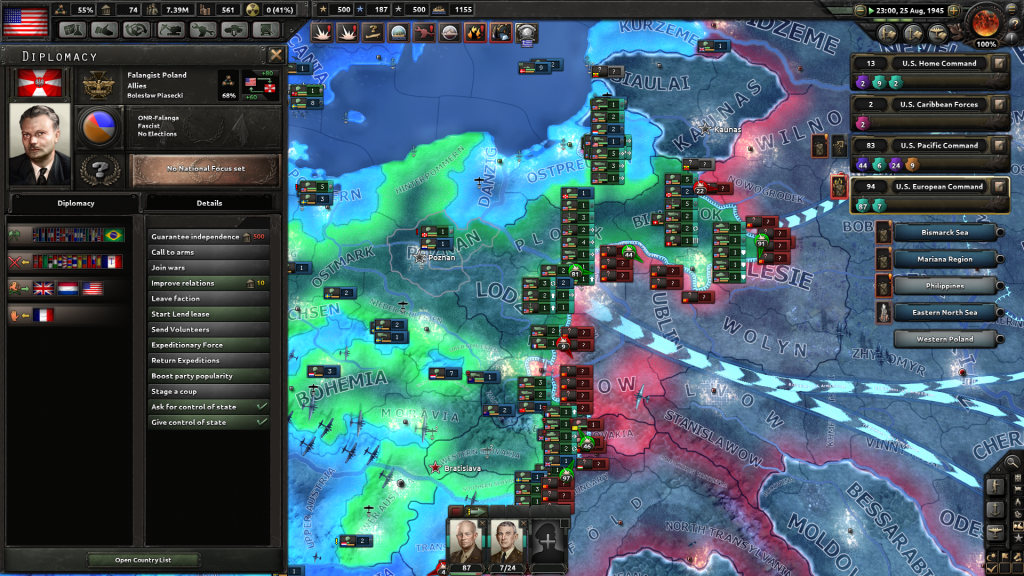
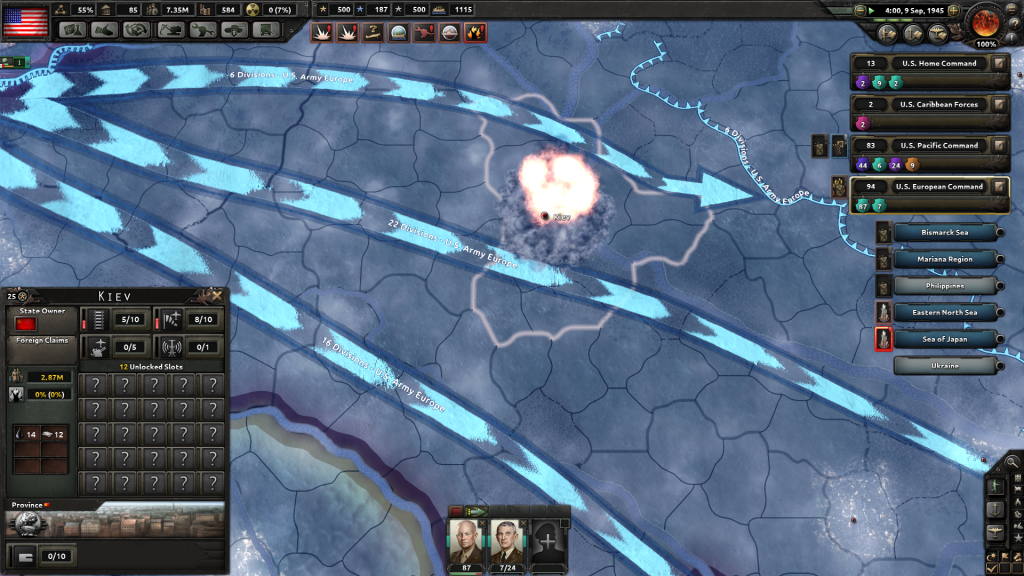
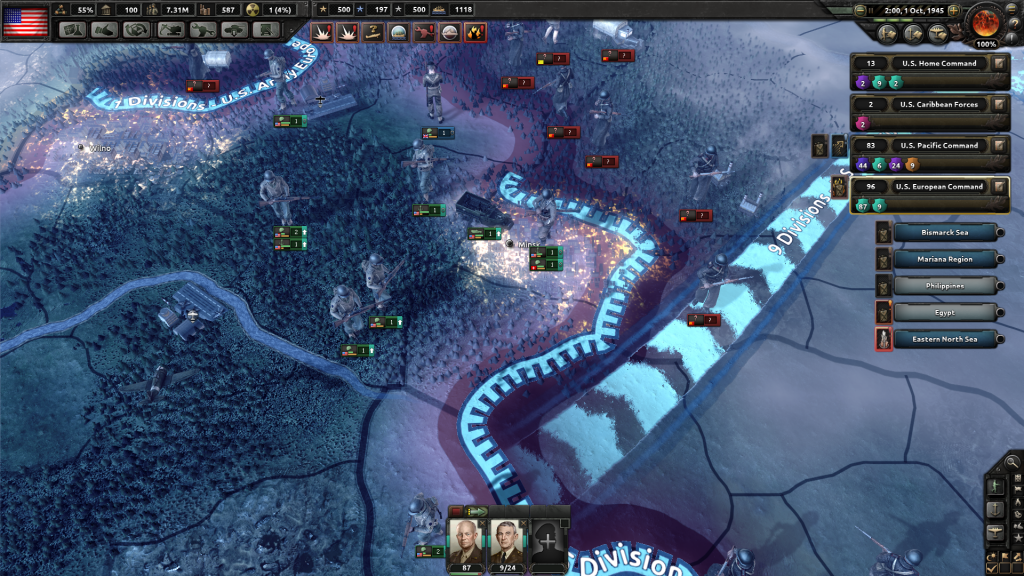
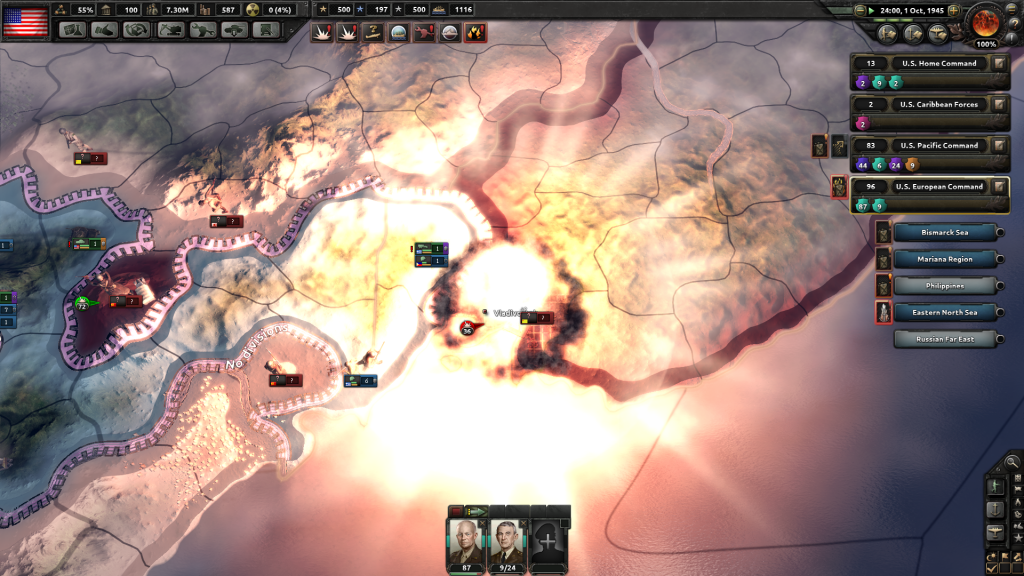
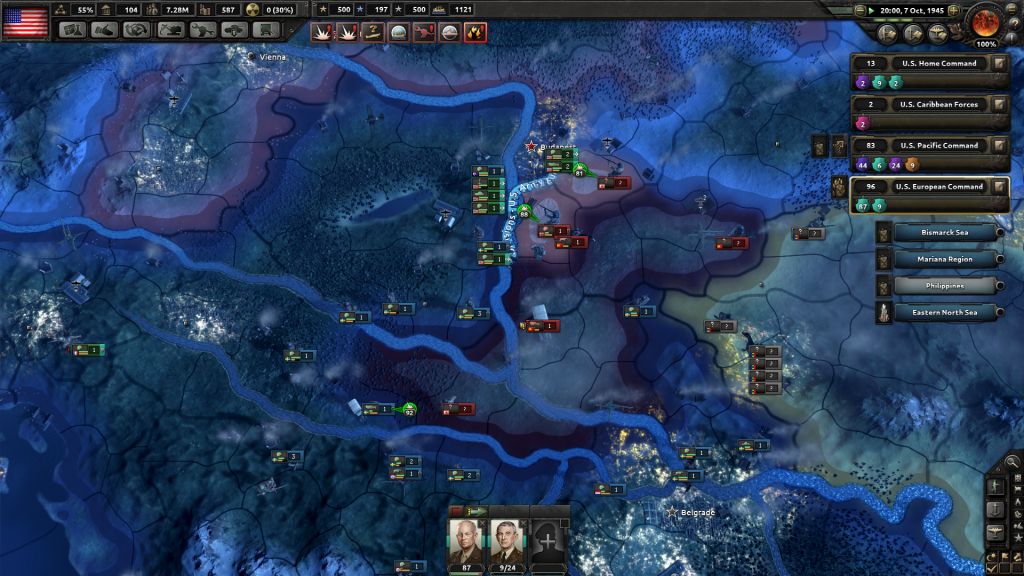
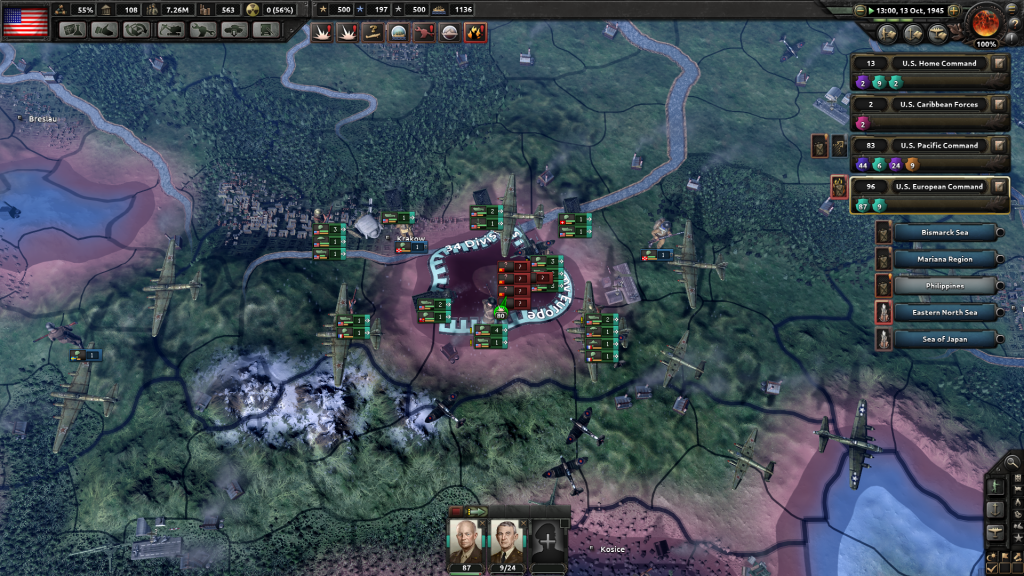
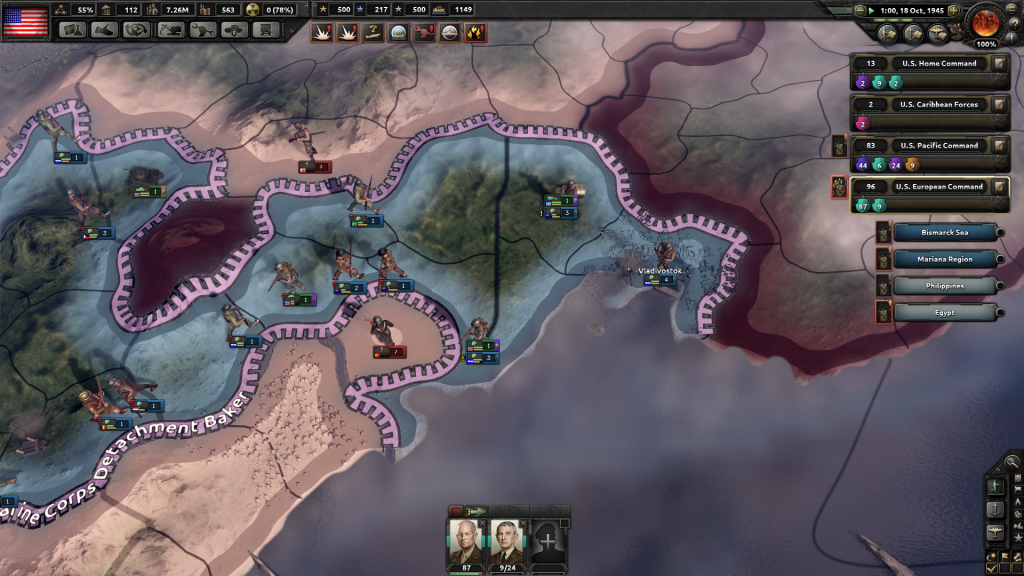
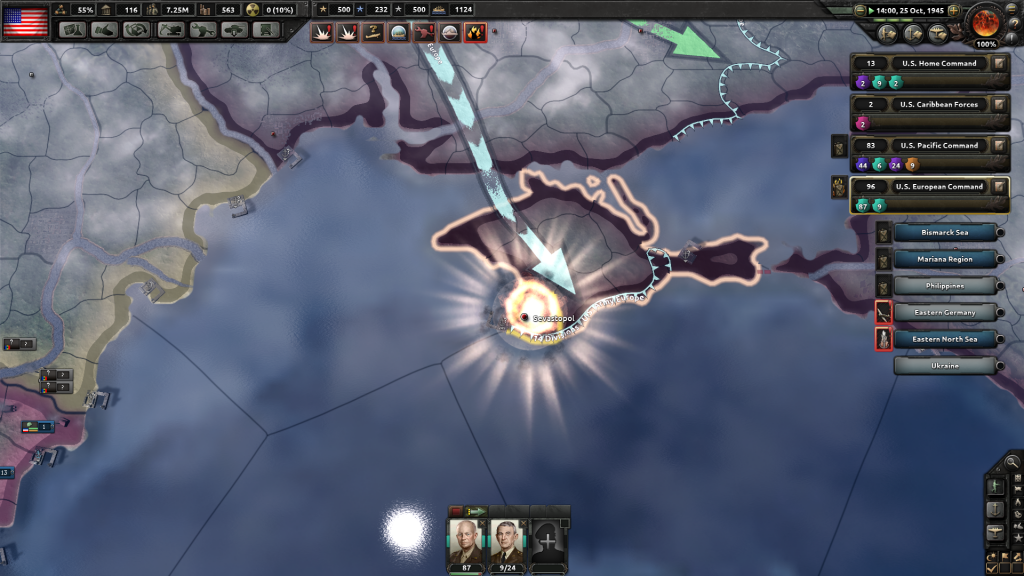
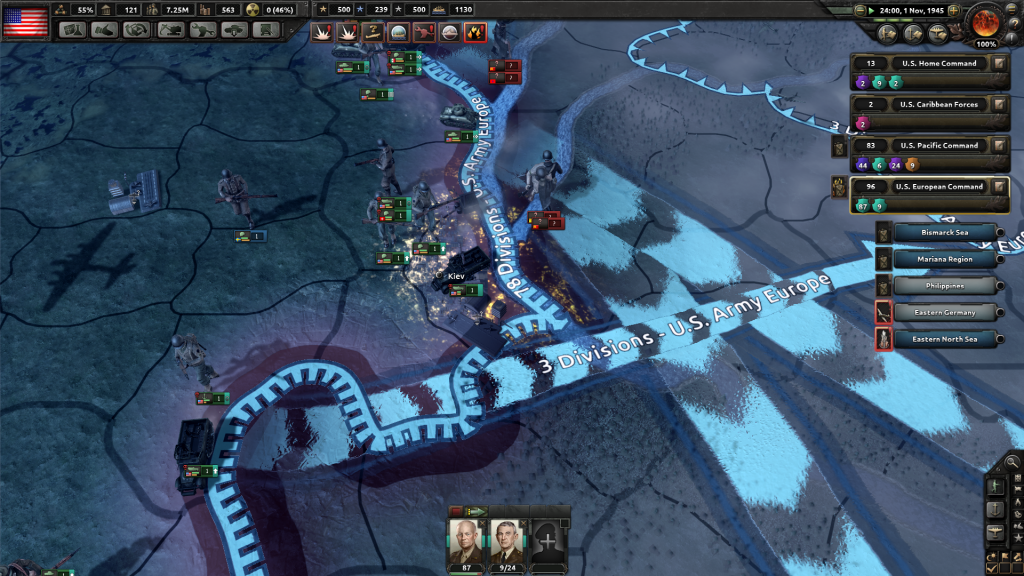
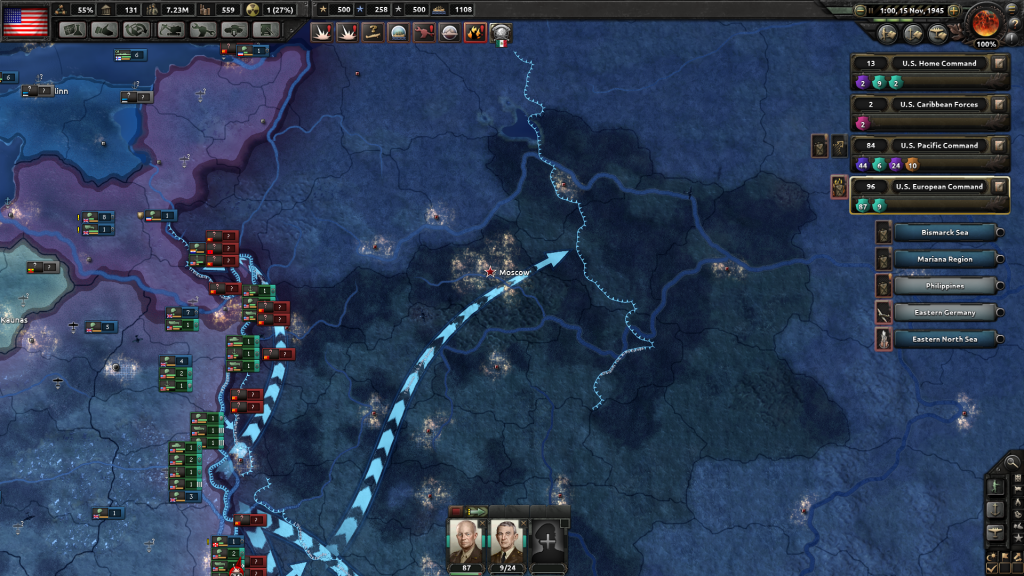
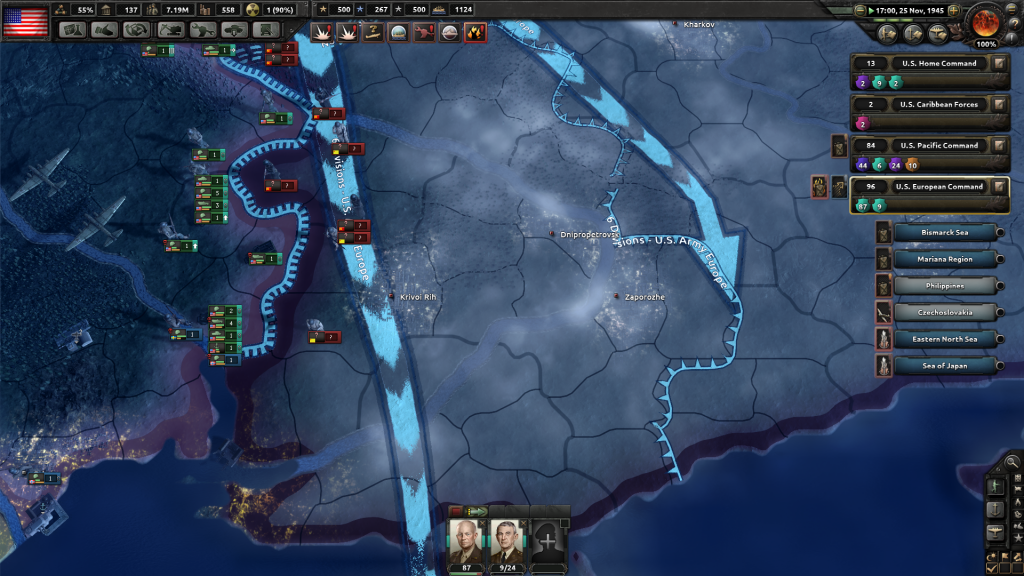
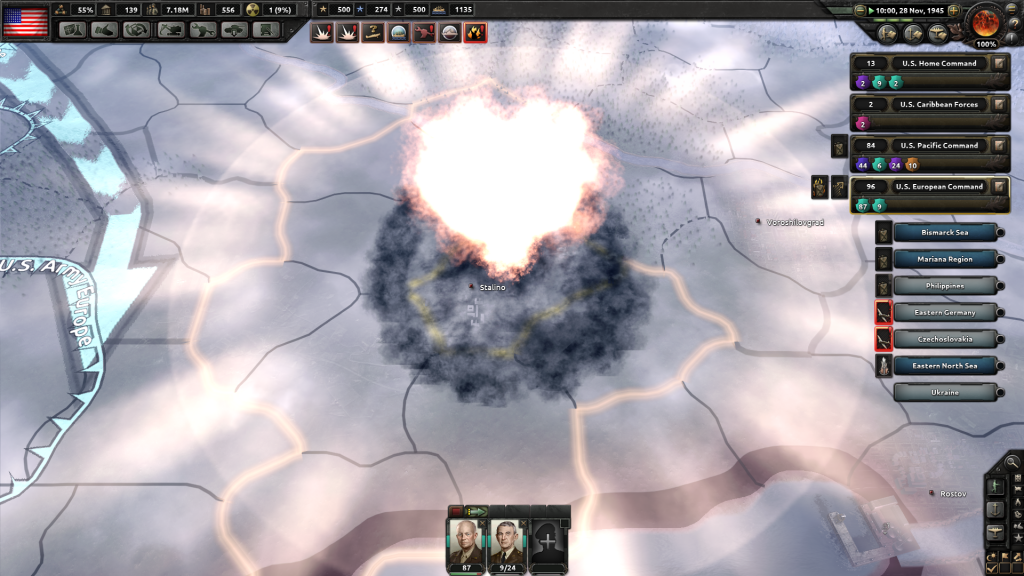
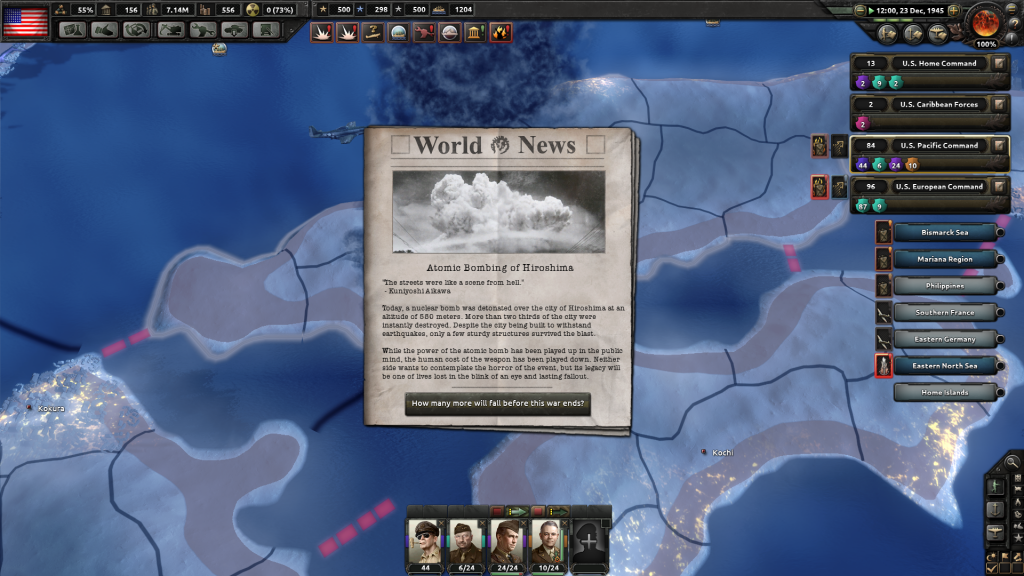
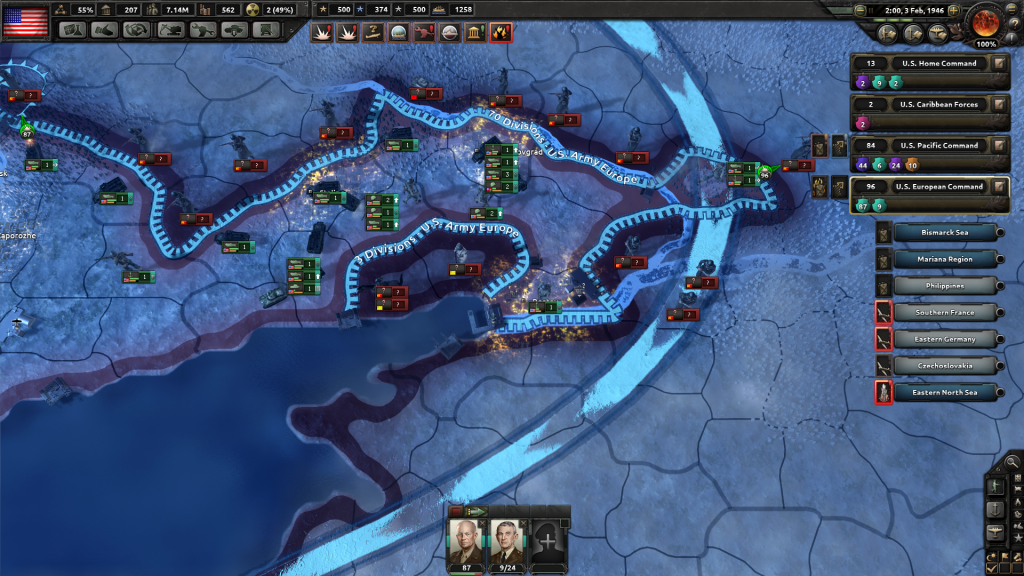
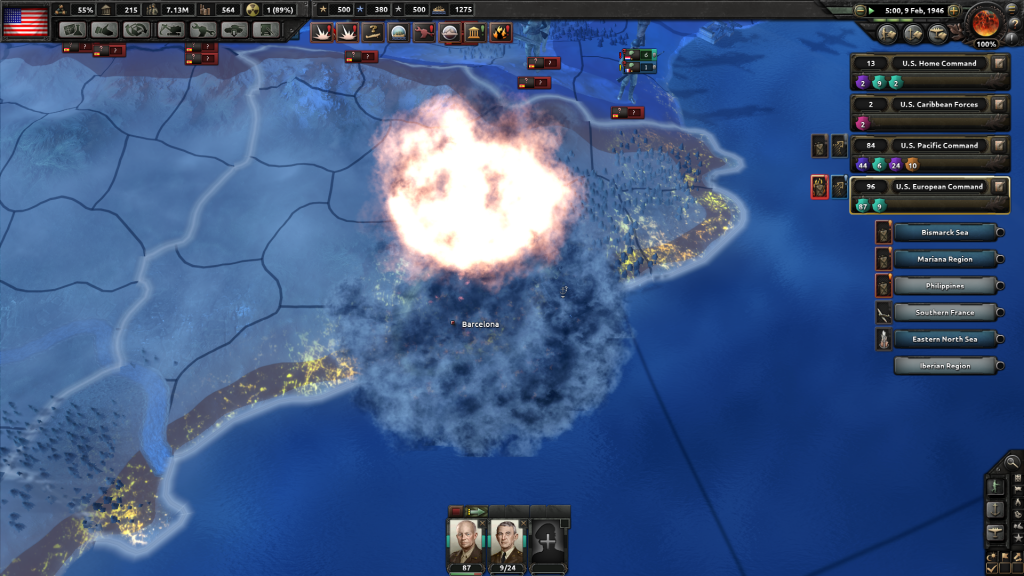
No Comments Yet